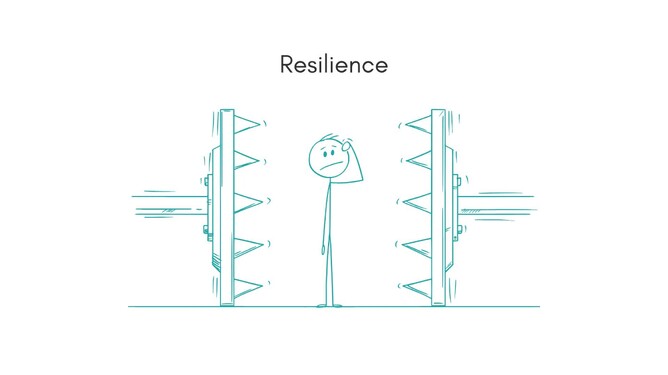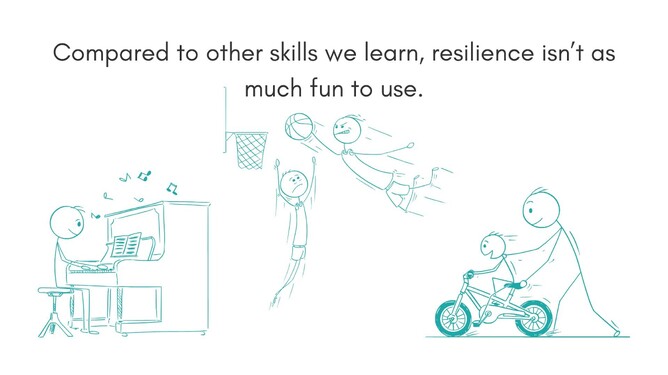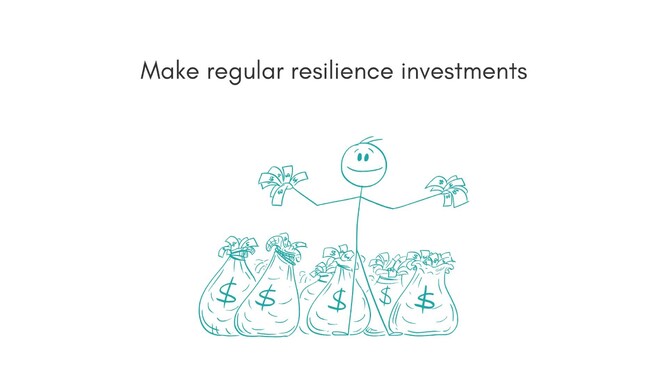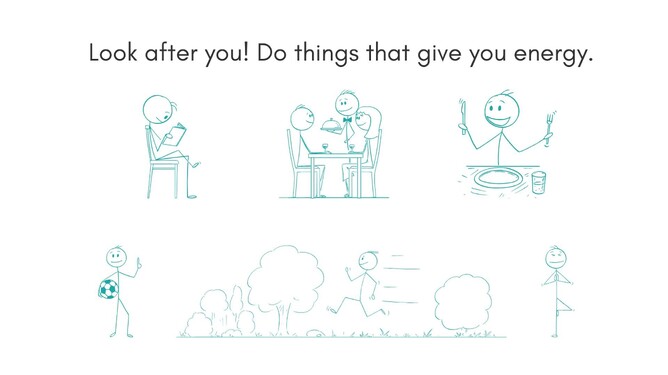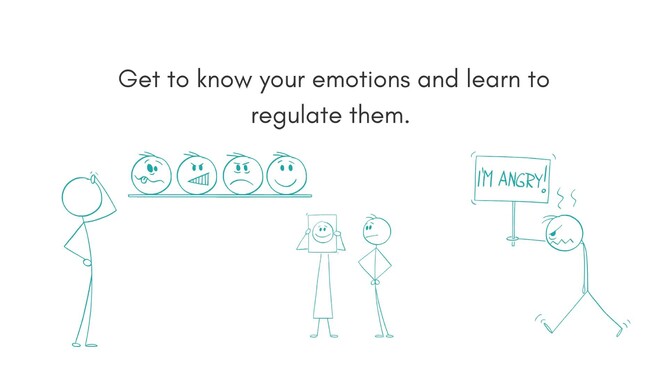Resilience is really nice to have. But compared to other skills, it isn’t particularly exciting to develop, and no one is ever especially keen to be in a situation where they get to use their resilience.
Let me explain: when you learn to play an instrument, you might find that difficult initially (I would), but eventually, you will get better and you will be able to play a piece of music. When you learn to ride a bike, you will fall off a few times, you might get hurt, but eventually, you will be able to ride a bike, and that might give you a sense of freedom or enjoyment. When you learn to knit, you might find the process frustrating, but eventually, once you have learned it, the pieces you create, e.g. a blanket or a jumper, might bring you great joy.
Resilience is different. Resilience is really useful to have, but hard to develop and not particularly pleasant to use. Where you might enjoy the fact that you can now ride a bike or play a piece of music, or wear your hand-made jumper, I am yet to hear someone say, ‘I am so glad I got to use my resilience today. That was awesome.’
There is another word and concept that is useful in this context: anti-fragile.
Let’s look at what those two words actually mean. According to the Oxford English Dictionary, ‘resilience’ is the ability to recover quickly from difficulties or to spring back into shape. It can also refer to the ability of people or things to feel better after an unpleasant experience. ‘Antifragile’, on the other hand, describes a situation where a system or a person gets stronger as a result of stress or pressure. So, resilience means you can get yourself back to the original level after experiencing hardship or challenge, whereas antifragility means you get to a higher level after overcoming difficulties. Sounds nice, doesn’t it? Many people use the terms interchangeably. I prefer the meaning of antifragile, but I like the word resilience better. So, for ease, I’ll stick to ‘resilience’ for this blog.
A common misconception is that if you are highly resilient, you don’t find challenges difficult, you are not as phased by them, and they don’t affect you as much. This is not true. You are simply better equipped to deal with challenges. But as you experience the struggle, it is still difficult. No matter how much resilience you have. (So, make sure you still support your resilient friend when they are going through a tough time.)
Resilience is difficult to measure exactly and hard to describe. One way to think about building resilience is through the analogy of investment. If you make regular investments into your different resilience accounts, for example:
Relationships
Clarify purpose & values
Self-awareness
Healthy habits
Planning
etc.
You are likely to be more resilient when you need to be. Take your relationships, for example, your inner circle, your mentors, your acquaintances. The connections and relationships you have, the level of closeness and trust shared between you and the other people in your life, are an essential part of resilience. People who have a strong support team approach and navigate situations with more resilience because they know they have support. They don’t have to do it alone. So invest in building your relationships before you need them. (You can also go back to my blog ‘The Conversation is the Relationship’.)
Another ‘account’ of your resilience investments is preparation and planning. Investing in planning and preparation skills is really useful. They enable you to anticipate challenging situations, and they allow you to plan for potential scenarios. It also means that as you are facing a challenging situation, you can step back. You can consider what you have prepared for or what you have experienced in the past, and how that might help you navigate this situation. With this broader perspective, you are less likely to get overwhelmed. It doesn’t mean you won’t ever get overwhelmed at all, but it is less likely.
Similarly, you can ‘invest’ in your resilience by stacking healthy habits like regular exercise, staying hydrated and eating well. Spending time outside and off screens, pursuing a hobby or doing something outside of work that you enjoy, can help strengthen your resilience.
These are all things you can use to build your resilience while things are going well. This is your preparation for challenges that inevitably arise in life. There are also some things you can do when you are in the middle of a challenge. When you find yourself in a situation where you need to use your resilience, it can also be useful to figure out what you can actually control. A useful way to look at this is through the circle of control. Ask yourself:
What can I control?
What can I influence?
What can I not control?
Here are some examples:
Your effort, your focus, your preparation, your planning, your attitude, your response to events and situations, your communication, etc., are all within your control. You are able to influence your relationships, your support team, your health, etc. And you can’t control the weather, injuries, other people’s opinions and judgements, the current economic climate, etc.
Sometimes we worry about potential or real challenges so much that it starts to drain our energy. This worrying about what might happen can also take a toll on your resilience. There is a simple strategy you can try to help clear the ‘what if’ questions from your mind. It can be easy to think of the worst-case scenarios, for example:
What if we break up?
What if I lose my job?
What if I don’t get selected?
What if I don’t find anyone to talk to?
Etc.
We can go round and round in circles asking ourselves these questions. So, instead of wasting energy asking yourself these questions, answer them. Decide what you will do if you find yourself in that situation:
If we break up, I will…
If we don’t qualify,...
If I don’t get selected,...
If I lose my job…
Answer the question. Make a plan. That way, you won’t start from scratch, and you won’t be as panicked if the situation does arise. But, more importantly, you will likely stop worrying because you have a plan. This stops the thought loops and protects your energy and your resilience bank.
Lastly, it strengthens your resilience if you are aware of and understand your own emotions and even better if you can regulate them too. I have written about this recently, so please check out the two blogs on Emotions and Emotion Regulation to learn more.
Thank you for reading this week’s blog. Means the world to me that you are taking the time to read my words. Take care & till next week. (To receive these blogs via my newsletter, subscribe here)
Key Points:
Resilience is great to have, but not fun to develop or use.
Resilience can be actively & deliberately built.
Even if you are highly resilient, you will still find challenges difficult. You are simply better equipped to navigate them.
Reflection Questions:
When have you last had to be resilient?
How well do you understand emotions, and how well can you regulate yours?
What is the balance on your resilience investment accounts? Any you could invest in this week?
